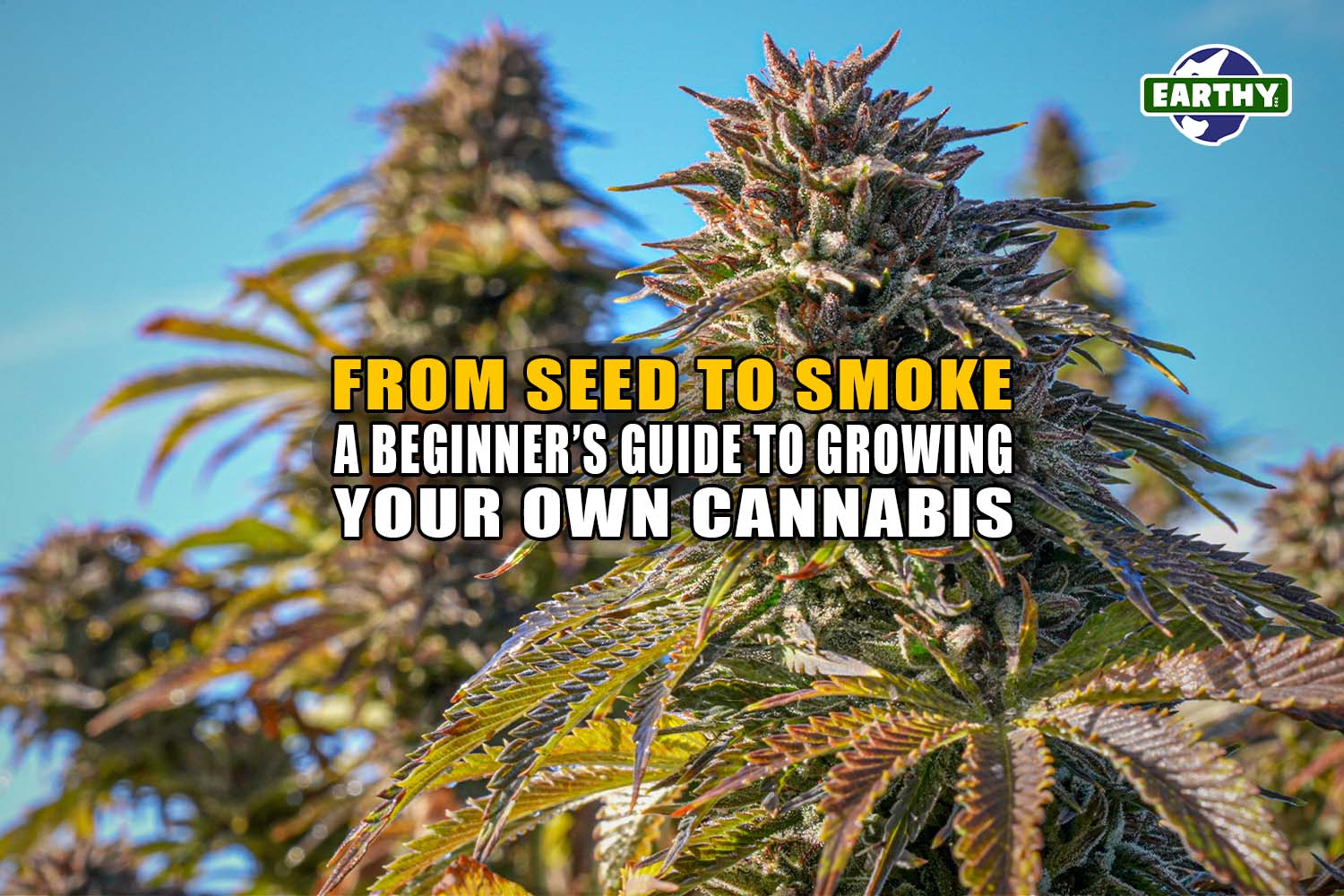Growing your own cannabis can be a rewarding and enjoyable hobby, providing you with high-quality buds and a deep connection to the growing process. Whether you’re a beginner grower or have some experience with other plants, this guide will walk you through everything you need to know about cannabis cultivation. Here, we’ll cover everything from selecting cannabis seeds to harvesting your homegrown marijuana or hemp.
Understanding cannabis basics
Cannabis plants come in various types, primarily indica, sativa, and hybrids. Each variety has particular characteristics. For example, indica plants tend to provide relaxing effects. In contrast, many enjoy sativa plants for their energizing properties. Finally, hybrids offer a mix of both in any combination [1]. Thus, when choosing cannabis seeds, it’s best to opt for strains that resonate with your intended purposes. Also, you can choose auto-flowering strains, which flower automatically after a certain period, or photoperiod plants, which require a change in the light cycle to induce flowering [2].
Legal considerations
Before you start growing cannabis, it’s crucial to understand the local laws regarding cannabis. In other words, cannabis regulations vary by region. Therefore, growers must adhere to local laws to avoid legal issues. Make sure you grow within the limits set by your local government, both in terms of the number of plants and the conditions under which they are grown [3].
Can Legalization Lower the Carbon Footprint of Cannabis
Growing your own cannabis indoors or outdoors
Cultivating cannabis indoors or outdoors comes with unique sets of advantages and challenges. For example, when you grow indoors, you have greater control over the environmental conditions, which can be crucial for healthy cannabis plant development. However, indoor growing often involves using artificial lighting, such as high-pressure sodium (HPS) bulbs or light-emitting diode (LED) lights, to provide the necessary light spectrum. Ultimately, this setup allows you to grow weed indoors regardless of the outdoor weather conditions, making it possible to cultivate cannabis year-round [4].
On the other hand, growing cannabis outdoors allows plants to benefit from direct sunlight, which is more cost-effective than artificial lighting. Additionally, outdoor cannabis plants have more space to grow unimpeded. As a result, harvests may include larger plants and higher yields. However, outdoor cultivation requires a suitable climate and more attention to weather patterns, as extreme conditions can affect plant health. Also, when you grow cannabis outdoors, the plants risk exposure to pests and animals. Moreover, outdoor growers must be diligent about monitoring male plants, especially if they have purchased unfeminized seeds. This step prevents them from pollinating female plants and causing them to produce seeds rather than buds. However, both growing methods require attention to detail and knowledge of all things cannabis related. Ultimately, the choice between indoor and outdoor growing depends on your specific needs and resources [4].
Setting up your grow space indoors
Deciding whether to grow cannabis indoors or outdoors marks a significant step for a grower. As we’ve mentioned, indoor growing allows for more control over the environment surrounding your cannabis seeds. These factors include temperature and humidity levels, light cycles, and fresh air circulation. Also, essential equipment for indoor growing includes grow lights (LED grow lights or HPS bulbs). You will also need high-quality potting soil, a hydroponic system, and a grow tent to best manage the indoor climate for growing weed [5].
Germination and seedling stage
First of all, be sure to start with high-quality seeds for healthy plant growth and make sure to include feminized seeds in your garden. This ensures you get female plants that produce buds. Next, germinate your seeds using the damp paper towel method or place them in a glass of water until the tap root appears. Once germinated, transplant your seedlings into the correct grow medium. Lastly, ensure they receive adequate hours of light and fresh air [6].
Vegetative stage
During the vegetative phase, your cannabis plants require at least 18 hours of light daily. Typically, the plants grow rapidly with this amount of light, developing strong roots and foliage in the grow cycle. Importantly, your growing space should have proper humidity control and temperature levels suitable for optimal plant growth. Also, use a high-quality growing medium and consider adding nutrients to support healthy cannabis growth. Pruning and training your plants can help maximize light exposure and promote a robust structure [7].
Perfect the flowering stage
The flowering phase begins when you switch the light cycle to 12 hours of light and 12 hours of darkness for photoperiod plants. This stage is critical for producing quality buds. Throughout this process, maintain optimal temperature and moisture levels and adjust nutrients to support flowering. Also, regularly check for signs of pests or diseases, such as root rot, and address any issues promptly to ensure healthy plant growth. Often, experienced growers use carbon dioxide enrichment to boost yields [8].
Harvesting and curing
Determining the right harvest time is key to achieving high-quality yields. For instance, look for visual cues such as the color change in pistils and trichomes. Harvest your plants by cutting them at the base and hanging them upside down to dry in a well-ventilated area. If you’ve grown the plants in your primary residence, consider hanging them close to a window that is opened occasionally. Once dried, cure your buds in airtight containers to enhance flavor and potency [9]. Whether you grow indoors or outdoors, proper curing results in smooth, enjoyable homegrown cannabis.
How is Organic Cannabis Harvested?
Troubleshooting common problems
Growing cannabis can be challenging, especially for beginner growers. For instance, common issues may include pest infestations, nutrient deficiencies, and environmental stresses. Therefore, it’s crucial to regularly inspect your plants for signs of problems and take corrective action as needed [10]. If you grow indoors, ensure your space has adequate fresh air circulation and humidity control to prevent mold and mildew. Remember that learning from experienced growers and joining online forums can provide valuable insights into managing these challenges.
Enjoying your homegrown cannabis
Once you harvest and cure your cannabis, you can enjoy it in various ways. Whether you prefer smoking, vaping or edibles, homegrown cannabis offers a sense of accomplishment and satisfaction. On the other hand, you may decide to experiment with different consumption methods to find what works best for you. Sharing your harvest with friends can be a great way to enjoy your homegrown indica and sativa plants.
3 Surprisingly Useful Hemp Products
Exceptional cannabis products from Earthy Now
For cannabis enthusiasts seeking reliable, trustworthy sources of cannabis flower and other hemp-derived products, Earthy Now has something for everyone. These products are the industry’s cleanest and strongest, with only trace amounts of Delta-9 THC.
Explore these natural, organic products from Earthy Now:
- CBD Flower
- Gummies
- Lozenges
- Tablets (THC Free!)
- Soothing Relief Lotion
- Soothing Relief Salve
- CBD Pet Tinctures (no THC!)
- Oils
- Pre-Rolls
- Smokes
- Terpenes
Key takeaway: growing your own cannabis is rewarding
Growing your own cannabis requires patience, attention to detail, and a willingness to learn. From selecting the right cannabis seeds to mastering the flowering stage, each step is crucial for producing high-quality yields. Whether you’re growing weed indoors or outdoors, following best practices and staying informed about local laws will help you grow pot successfully and enjoy the fruits of your labor.
For further learning, explore books, websites, and forums dedicated to cannabis cultivation. For example, local gardening clubs and seeking out other cannabis cultivators may provide additional support and advice. As you gain experience, you’ll find growing marijuana or hemp to be a deeply rewarding hobby that connects you with the plant and its many benefits.
For premium cannabis flower grown to perfection, visit Earthy Now and find your favorite strain!
Medical Disclaimer / Legal Disclaimer – Information is provided for educational purposes. It does not and is not intended to constitute legal advice or medical advice. We attempt to be accurate and up-to-date, but the legality of cannabinoids and the science of cannabis are evolving. The author is neither a legal professional nor a medical expert. Before buying or using any products, you should check with your local authorities and medical providers.
References
- Sativa vs Indica
- Wikipedia: Autoflowering Cannabis Seeds
- Cannabis Business Law
- Growing Weed Indoors vs Outdoors: Pros and Cons
- How to Grow Cannabis Indoors: Initial Setup
- Mastering the Cannabis Seedling Stage
- The Guide to the Vegetative Stage For Indoor Weed Growers
- Week-by-Week Timeline of the Cannabis Flowering Stage
- A Beginner’s Guide to Harvesting, Drying, and Curing Cannabis
- 6 Common Problems Cannabis Growers May Encounter
- How To Set Up Indoor Grow Lights for Cannabis Growing
- How to Get More Female Plants From Regular Cannabis Seeds
- Grow Cannabis Outdoors




 Earthy Now
Earthy Now